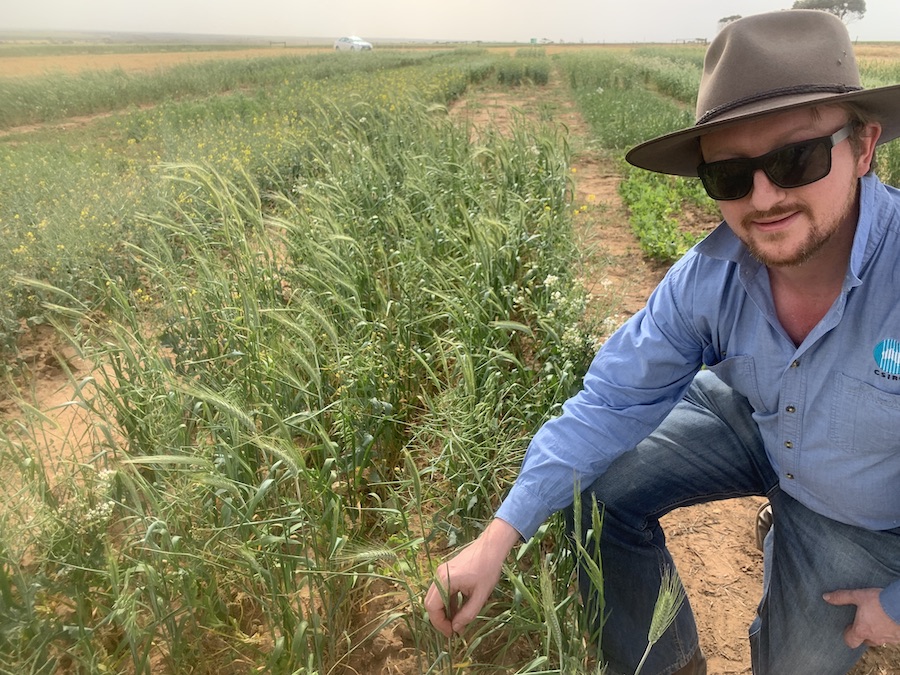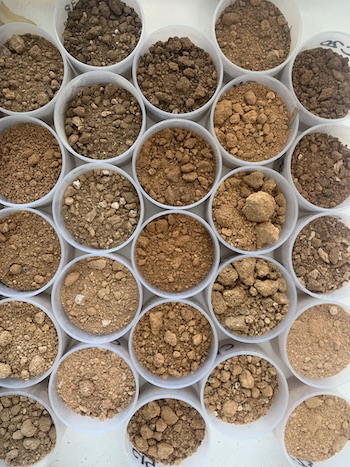Cover crops can provide diverse farming system benefits that have the potential to lift the sustainability and resilience of crop production in south-eastern Australia.
These non-cash crops, grown as mixed or single-species, may replace a winter or summer fallow before a cash crop and primarily function to cover, protect and improve the soil.
Studies around the world show cover crops can provide multiple farming system gains. These include improved soil health, soil organic carbon, nutrient management, and weed, disease and pest suppression, leading to increased productivity and profitability in the cash crops that follow.
Many growers have tested cover cropping programs in the southern grains region, but limited research-based knowledge has posed a barrier to widespread adoption.
Helping to bridge this knowledge gap is a four-year research consortium led by Regional Connection director Mark Stanley and the Ag Excellence Alliance, which road-tested cover cropping across Australia’s south-eastern states. CSIRO principal research scientist Dr Mark Farrell was the lead scientist for the work.
The consortium consisted of the Ag Excellence Alliance, CSIRO and the South Australian No-Till Farmers Association (SANTFA) with co-investment from the Australian Government’s National Landcare Program, GRDC and the South Australian Department for Environment and Water.

CSIRO principal research scientist Dr Mark Farrell explored the effects of cover crops in different growing environments across south-eastern Australia. Photo: CSIRO
It was supported by a network of grower groups that facilitated on-farm trials to study the effects of cover crops in different growing environments spread over SA, Victoria and Tasmania, representing high, medium and low-rainfall areas.
The grower groups included Agricultural Innovation and Research Eyre Peninsula (AIR EP), Agriculture Kangaroo Island (Ag KI), MacKillop Farm Management Group (MFMG), Mallee Sustainable Farming (MSF), Murraylands and Riverland Landscape Board, Southern Farming Systems (SFS) and Upper North Farming Systems (UNFS). Plus, the study involved entomologist Dr Michael Nash, who is managing director at agro-ecology consultancy Advanced Invertebrate Management.
Dr Farrell says the research collaboration explored how cover crops affect soil health, nutrient cycling, organic carbon and moisture content, as well as invertebrate populations and the yield of the following cash crop.
It also tested the performance of warm and cool-season species and varieties suited to winter and summer programs in different agroecological areas, and the optimum approach for terminating a cover crop.
The study, spanning three states from 2018–21, comprised 20 paddock-scale ‘demonstration’ trials, termination trials, species evaluation trials and invertebrate monitoring sites.
The paddock-scale trials saw growers produce both multi and single-species cover crops in the winter or summer preceding a winter cash crop. The performance of these covers was compared with a control paddock managed as a traditional summer or winter fallow.
Performance patterns

The research found multi-species crops appear to provide greater farming system benefits than single-species crops. Photo: CSIRO
Dr Farrell says that, overall, the trial program showed cover crop performance was “climate-driven”, and highly variable depending on where crops were grown in the southern grains region.
Specifically, the paddock trials found that cover cropping was a beneficial practice in high-rainfall areas, where it generally improved soil health and increased the yield of the following winter cash crop.
These gains were observed in high-rainfall trials on SA’s Kangaroo Island and the Lower Eyre Peninsula, as well as in Victoria and Tasmania.
In contrast, cover cropping was sometimes found to be counterproductive in low-rainfall areas, where it typically had adverse effects on soil health and caused a yield penalty in the following cash crop.
Demonstrating this trend in a high-rainfall farming system were paddock trials on Will and Jenny Stanton’s property near Stokes Bay on the north coast of Kangaroo Island, SA.
The Stantons grew a single-species crop of French white millet and a mixed-species crop of French white millet, fodder rape, sorghum and tillage radish in the 2020-21 summer. Control paddocks were managed as summer fallow.
Dr Farrell says the cover crops, sown in December 2020 and terminated in March 2021, increased the yield of the following oats cash crop, grown during the 2021 winter growing season, by one tonne per hectare.
Analysis of soil layers to a depth of 70cm on the Stanton farm showed that cover crops had increased soil organic carbon in the subsoil at a depth of 20-30cm. The increased soil organic carbon was higher following a multi-species crop, compared with a single-species crop, in the two-year period when the covers were grown.
 Dr Mark Farrell found that glyphosate spraying was the most effective approach to cover crop termination. Photo: CSIRO
Dr Mark Farrell found that glyphosate spraying was the most effective approach to cover crop termination. Photo: CSIRO
But a different picture of cover cropping emerged in low and medium-rainfall areas.
“Farming systems in low-rainfall areas may not benefit from integrating a summer cover crop,” Dr Farrell says.
An exception to this general rule is when a summer cover is grown opportunistically in response to high summer rainfall, and its water use is carefully monitored, he says.
“Growers have the option of replacing a winter cash crop with a winter cover crop. However, the soil health benefits of growing a winter cover crop are likely to be reduced in situations where it is grazed or cut for hay.
“Growing a cover crop in winter means there is an opportunity cost of not producing a winter cash crop, but it may still be beneficial compared with a winter fallow.”
The paddock trials also showed that cover crop performance was the most variable in medium-rainfall areas.
“Medium-rainfall growers have the option of growing either a summer or winter cover crop, but both pose a risk of causing yield and soil health penalties, depending on seasonal conditions,” Dr Farrell says.
“The outcomes of cover cropping in medium-rainfall areas could be positive, neutral or negative.”
The climate-driven outcomes in low, medium and high-rainfall areas were consistent with soil analysis findings, he says. These showed that cover crops decreased moisture content in soil surface layers at roughly half of the on-farm trial sites.
“However, this soil moisture loss did not necessarily result in a yield penalty where the following cash crop received significant in-crop rainfall.”
Another important finding of the study was that multi-species crops appear to provide greater farming system benefits than single-species crops, he says.
Slow-release nitrogen
 Researchers analysed soil samples collected from paddock trial sites to determine how cover cropping influenced soil nitrogen supply. Photo: CSIRO
Researchers analysed soil samples collected from paddock trial sites to determine how cover cropping influenced soil nitrogen supply. Photo: CSIRO
The influence of cover cropping on soil nitrogen supply was a major finding of the research that examined soil core samples, collected to a depth of one metre, from the on-farm trial sites.
Dr Farrell says soil analysis showed that cover cropping had converted topsoil nitrate nitrogen, which is potentially vulnerable to losses, into other slow-release organic forms of nitrogen that become plant-available to the following cash crop during the winter growing season.
“In effect, cover crops provided a supply of soil nitrogen for cash crops that would otherwise have been vulnerable to leaching losses.”
He explains that cover crops reduced the amount of leaching-prone, nitrate nitrogen in surface soil layers.
The nitrate nitrogen was converted into soluble organic nitrogen and microbial nitrogen, which are not immediately plant-available, but less vulnerable to loss. These forms of nitrogen behave like slow-release fertilisers, he says.
“Nitrogen taken up by the cover crop as nitrate was returned to the soil as organic forms after the crop was terminated at flowering.”
He says the study also found that, overall, glyphosate spraying was the most effective approach to cover crop termination, compared with mechanical methods using a roller crimper or slashing.
“The effectiveness of termination using a roller crimper was variable, depending on plant growth, especially stem thickness and length,” Dr Farrell says.
Other findings of the research, some of which are site-specific, included:
- tillage radish helped ameliorate compacted soils. The crop’s robust tap and lateral roots penetrated deep into the soil profile, helping to break up compaction, but its growth can be limited in soils with low moisture retention;
- tillage radish can produce useful vegetative biomass for grazing or mulching;
- tillage radish that persists over the green bridge can become a host for cutworms (moth larvae). But in situations where the crop is not terminated, cutworm preference for tillage radish as a host species was beneficial to other crops that showed low pressure from the pest;
- aerial spreading of seed was an effective approach to cover crop establishment on Kangaroo Island;
- spring sowing was more effective than summer sowing for warm-season crop species. Spring-sown cover crops may not be viable every year, but they can be grown opportunistically in favourable seasonal conditions;
- visual assessment showed a multi-species crop improved soil structure (aggregation). The diverse mix of species appeared to improve soil health, with low expenditure on fertiliser inputs, based on paddock trials at Waikerie, SA;
- tillage radish, faba beans, wheat, cereal rye, oats and sunflowers were effective summer cropping options, but ryegrass dominance can prevent these species from reaching full maturity, based on trials at Langhorne Creek, SA;
- some cover crop species were linked to pest suppression; and
- after two seasons of cover crops, visual assessment of the following spring-sown barley crop showed extra vegetative biomass, based on trials at Sisters Creek, Tasmania.
“This project examined the impact of a limited-intervention approach to cover cropping in southern farming systems, where it may only be practical to establish a cover crop once every few years,” Dr Farrell says.
“Against this backdrop, positive and negative effects of cover crops were observed in all rainfall zones.
“While the chances of success with a cover crop are greater in the high-rainfall zone, this should not be assumed.
“Conversely, in the low-rainfall zone, carefully managed opportunistic cover cropping may result in improved soil health outcomes,” he says.
More information: Mark Farrell, mark.farrell@csiro.au

























































